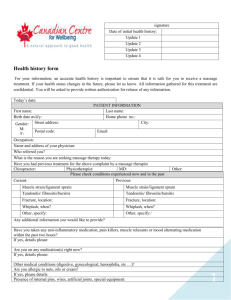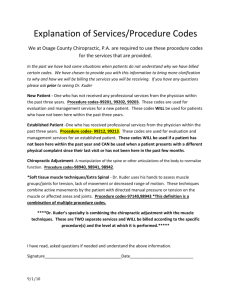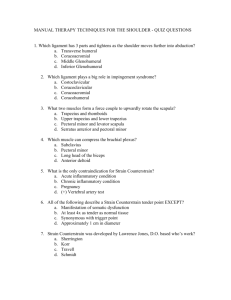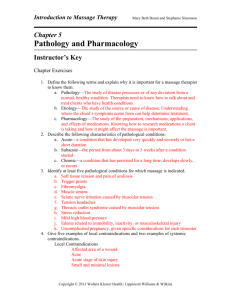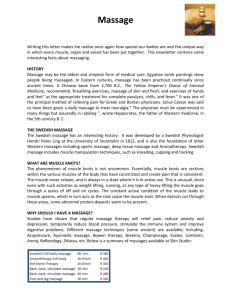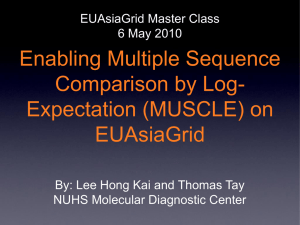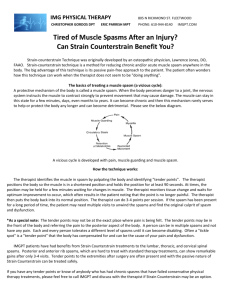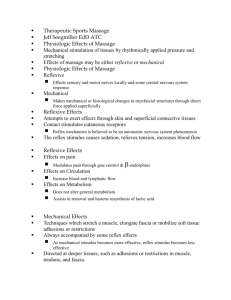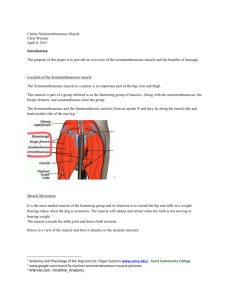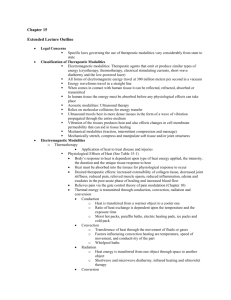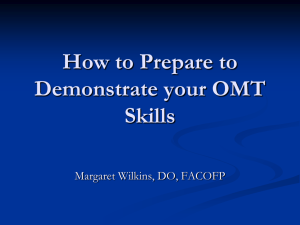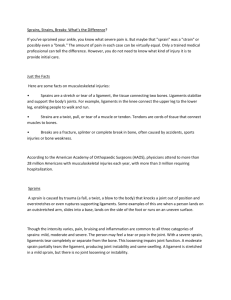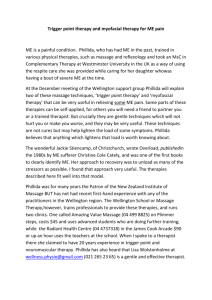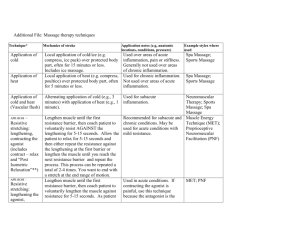Soft Tissue - aaronsworld.com
advertisement
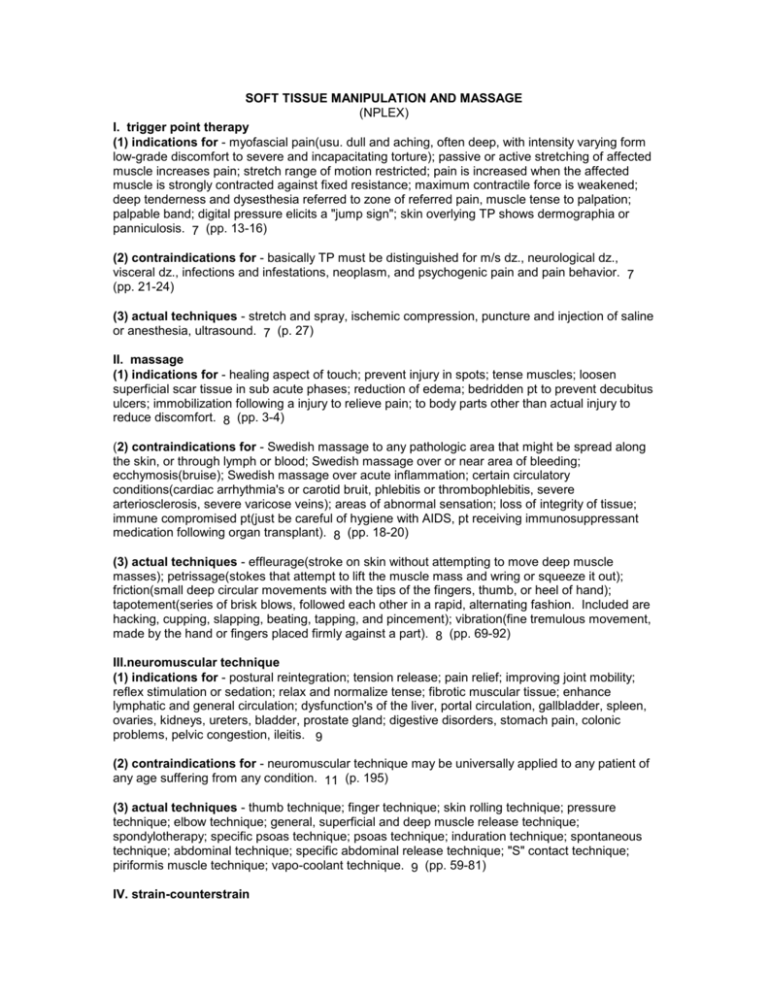
SOFT TISSUE MANIPULATION AND MASSAGE (NPLEX) I. trigger point therapy (1) indications for - myofascial pain(usu. dull and aching, often deep, with intensity varying form low-grade discomfort to severe and incapacitating torture); passive or active stretching of affected muscle increases pain; stretch range of motion restricted; pain is increased when the affected muscle is strongly contracted against fixed resistance; maximum contractile force is weakened; deep tenderness and dysesthesia referred to zone of referred pain, muscle tense to palpation; palpable band; digital pressure elicits a "jump sign"; skin overlying TP shows dermographia or panniculosis. 7 (pp. 13-16) (2) contraindications for - basically TP must be distinguished for m/s dz., neurological dz., visceral dz., infections and infestations, neoplasm, and psychogenic pain and pain behavior. 7 (pp. 21-24) (3) actual techniques - stretch and spray, ischemic compression, puncture and injection of saline or anesthesia, ultrasound. 7 (p. 27) II. massage (1) indications for - healing aspect of touch; prevent injury in spots; tense muscles; loosen superficial scar tissue in sub acute phases; reduction of edema; bedridden pt to prevent decubitus ulcers; immobilization following a injury to relieve pain; to body parts other than actual injury to reduce discomfort. 8 (pp. 3-4) (2) contraindications for - Swedish massage to any pathologic area that might be spread along the skin, or through lymph or blood; Swedish massage over or near area of bleeding; ecchymosis(bruise); Swedish massage over acute inflammation; certain circulatory conditions(cardiac arrhythmia's or carotid bruit, phlebitis or thrombophlebitis, severe arteriosclerosis, severe varicose veins); areas of abnormal sensation; loss of integrity of tissue; immune compromised pt(just be careful of hygiene with AIDS, pt receiving immunosuppressant medication following organ transplant). 8 (pp. 18-20) (3) actual techniques - effleurage(stroke on skin without attempting to move deep muscle masses); petrissage(stokes that attempt to lift the muscle mass and wring or squeeze it out); friction(small deep circular movements with the tips of the fingers, thumb, or heel of hand); tapotement(series of brisk blows, followed each other in a rapid, alternating fashion. Included are hacking, cupping, slapping, beating, tapping, and pincement); vibration(fine tremulous movement, made by the hand or fingers placed firmly against a part). 8 (pp. 69-92) III.neuromuscular technique (1) indications for - postural reintegration; tension release; pain relief; improving joint mobility; reflex stimulation or sedation; relax and normalize tense; fibrotic muscular tissue; enhance lymphatic and general circulation; dysfunction's of the liver, portal circulation, gallbladder, spleen, ovaries, kidneys, ureters, bladder, prostate gland; digestive disorders, stomach pain, colonic problems, pelvic congestion, ileitis. 9 (2) contraindications for - neuromuscular technique may be universally applied to any patient of any age suffering from any condition. 11 (p. 195) (3) actual techniques - thumb technique; finger technique; skin rolling technique; pressure technique; elbow technique; general, superficial and deep muscle release technique; spondylotherapy; specific psoas technique; psoas technique; induration technique; spontaneous technique; abdominal technique; specific abdominal release technique; "S" contact technique; piriformis muscle technique; vapo-coolant technique. 9 (pp. 59-81) IV. strain-counterstrain (1) indications for - headache, earache, tinnitus, veritigo, sinusitis, dental neuritis, neck pain, dysphagia, cough, precordial pain, heartburn, fatigue, epigastric pain, gastritis, ulcer, diaphragmatic hernia, umbilical pain, diarrhea or constipation, cystitis (non infectious), shoulder pain, arm pain, pain and numbness in hand or fingers, elbow pain, wrist pain, carpal tunnel syndrome, thumb pain and weakness, pain and weakness in grasp, low-back pain, hip pain, thigh pain, ankle pain, foot pain, knee pain, hip pain, coccygodynia, any joint dysfunction. 10 (pp. 3031) (2) contraindication for - information not found. (3) actual techniques - too numerous to list. Basically a joint is passively put in its greatest position of comfort; or strain and counterstrain: which relieves pain by reduction and arrest of the continuing inappropriate proprioceptor activity. This is accomplished by markedly shortening the muscle that contains the malfunctioning muscle spindle by applying mild strain to its antagonists. In other words, the inappropriate strain reflex is inhibited by application of a counterstrain. 10 (p. 11) 1. Gatterman, Meridel I.: Chiropractic Management of Spine Related Disorders, Baltimore, Md., 1990. 2. Schafer, R.C., Faye, L.J.: Motion Palpation and Chiropractic Technic - Principles of Dynamic Chiropratic, Huntington Beach, CA., 1990. 3. Landau, Steve: Relevent Material for the Principles and Practice of Manipulative Therapy, Portland, OR., 1981. 4. Kisner, Carolyn: Therapeutic Exercise - Foundations and Techniques, Philadelphia, PA., 1990. 5. Kirk, Constance. R.; Lawerence, Dana. J.; Valvo, Nila. L.: States Manual of Spinal, Pelvic and Extravertebral Technic, Department of Chiropractic National College of Chiropractic, Lombard, IL., 1985. 6. Mirkin, Gabe.; Hoffman, Marshall.: The Sports Medicine Book, Boston, MA., 1978. 7. Travel, J.G.; Simons, D.G.: Myofascial Pain and Dysfunction, Baltimore, MA., 1983. 8. Tappan, F.M.: Healing Massage Techniques - Holistic, Classic, and Emerging Methods, Norwalk, CT., 1988. 9. Chaitow, Leon: Neuro-Muscular Technique - A Practitioner's Guide to Soft Tissue Manipulation, Wellingborough, ENG., 1983. 10. Jones, L.H.: Strain and Counterstrain, Newark, OH., 1981. 11. Chaitow, Leon: Soft Tissue Manipulation, Wellingborough, ENG.,
